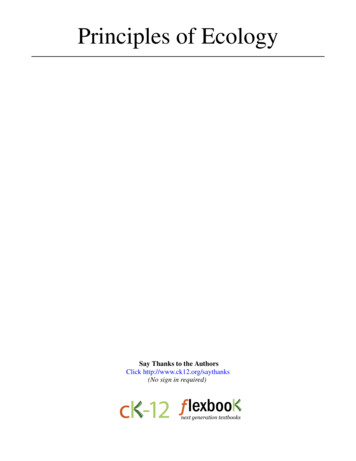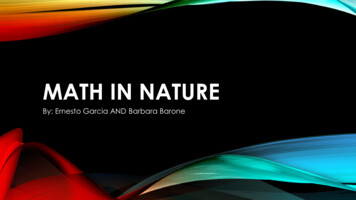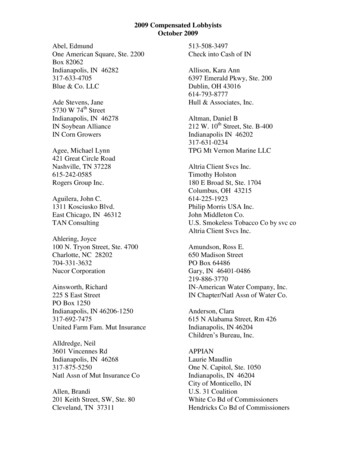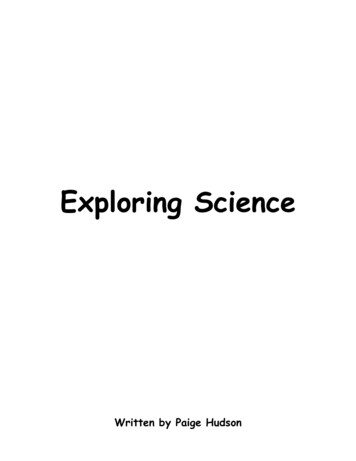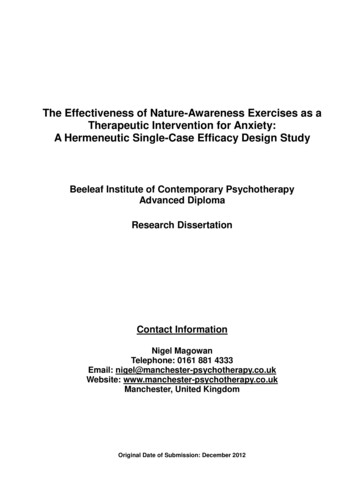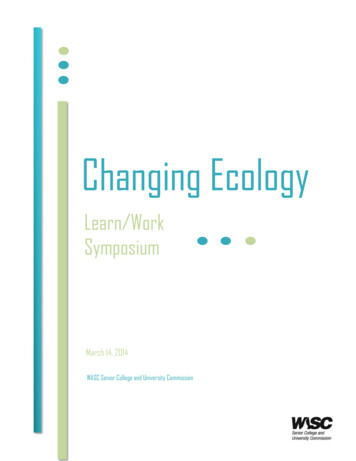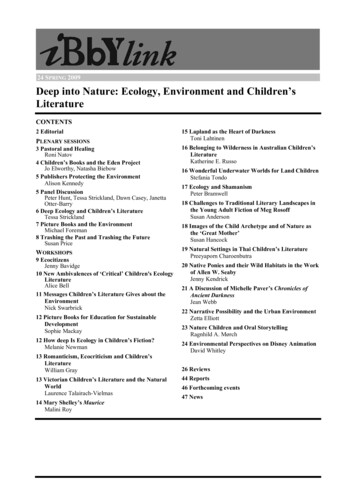
Transcription
24 SPRING 2009Deep into Nature: Ecology, Environment and Children’sLiteratureCONTENTS2 EditorialPLENARY SESSIONS3 Pastoral and HealingRoni Natov4 Children’s Books and the Eden ProjectJo Elworthy, Natasha Biebow5 Publishers Protecting the EnvironmentAlison Kennedy5 Panel DiscussionPeter Hunt, Tessa Strickland, Dawn Casey, JanettaOtter-Barry6 Deep Ecology and Children’s LiteratureTessa Strickland7 Picture Books and the EnvironmentMichael Foreman8 Trashing the Past and Trashing the FutureSusan PriceWORKSHOPS9 EcocitizensJenny Bavidge10 New Ambivalences of ‘Critical’ Children's EcologyLiteratureAlice Bell11 Messages Children’s Literature Gives about theEnvironmentNick Swarbrick12 Picture Books for Education for SustainableDevelopmentSophie Mackay12 How deep Is Ecology in Children’s Fiction?Melanie Newman13 Romanticism, Ecocriticism and Children’sLiteratureWilliam Gray13 Victorian Children’s Literature and the NaturalWorldLaurence Talairach-Vielmas14 Mary Shelley’s MauriceMalini Roy15 Lapland as the Heart of DarknessToni Lahtinen16 Belonging to Wilderness in Australian Children’sLiteratureKatherine E. Russo16 Wonderful Underwater Worlds for Land ChildrenStefania Tondo17 Ecology and ShamanismPeter Bramwell18 Challenges to Traditional Literary Landscapes inthe Young Adult Fiction of Meg RosoffSusan Anderson18 Images of the Child Archetype and of Nature asthe ‘Great Mother’Susan Hancock19 Natural Settings in Thai Children’s LiteraturePreeyaporn Charoenbutra20 Native Ponies and their Wild Habitats in the Workof Allen W. SeabyJenny Kendrick21 A Discussion of Michelle Paver’s Chronicles ofAncient DarknessJean Webb22 Narrative Possibility and the Urban EnvironmentZetta Elliott23 Nature Children and Oral StorytellingRagnhild A. Mørch24 Environmental Perspectives on Disney AnimationDavid Whitley26 Reviews44 Reports46 Forthcoming events47 News
EditorialI dived from my high wireinto the sea,that great briny restless churn of a mindwith its singing whales,mime-artist fish, writerly oysterspolishing up their poems of pearls;the genius seaflat on its back to stare at the moon,the trampoline moon.I bounced and I flew,watching the lost blue ball of the earthrolling through space.(Carol Ann Duffy (2000) ‘Going on the Web’in The Oldest Girl in the World)Lisa Sainsbury welcomed us to the fifteenthIBBY/NCRCL MA annual conference with thisquotation. She felt its range of images would helpus on our journey. ‘We hope to explore ecologicalissues and the types of environment experiencedby children and depicted by those writing forchildren, from urban dwellings to virtual space.’Much of this issue of IBBYLink is devoted toconference, held at Roehampton University on15 November 2008 and devoted to children’sliterature and the environment. Despite having hada record number of proposals for workshops, theactual numbers attending were a little lower thanrecent years, though there were well over ahundred, exclusive of speakers. Did some peoplefeel that they had already adequately imbibedecological messages, or was the credit crunchbeginning to bite? Nearly all the speakers havecontributed summaries of their talks, so thosereaders who were not able to attend should be ableto experience something of the day, while thosewho were at a particular workshop session will beable to learn about the ones they could not attend.Integral to the issue of the environment is thetheme of pastoral, a genre much used in the pastfor comment on contemporary issues, but alwaysfelt to embody a positive essence. Keynote speakerRoni Natov established a serious yet hopeful tonefor the conference by showing how two recentbooks focusing on teenagers with abuse problemsportray the healing power of the natural world.The Eden Project, constructed in a disusedindustrial landscape, has been an important agentnot only in addressing today’s environmentalchallenges, but also raising the awareness of youngpeople. Books have been a significant part of thisprocess, as highlighted by Jo Elworthy, itsDirector of Interpretation, and Natasha Biebow,who is responsible for the collaboration betweenEden and Random House, which has resulted in a2number of books showing children the role theycan play in protecting the environment.The panel discussion chaired by Peter Huntinvolved Tessa Strickland, who expressed thepowerful conviction about human interdependencewith nature that inspired her in the founding ofBarefoot Books, Dawn Casey, one of its authors,and Janetta Otter-Barry, from Frances Lincoln,another ecologically aware children’s publisher.After news about the work of IBBY, this yearincluding up-to-date information about the 2012Congress which will be held in London and thefund-raising Christmas cards with a picturegenerously donated by Jan Pieńkowski, one of thespeakers at last year’s conference, and lunch, therewere ten sets of parallel workshops, details ofwhich have been supplied for IBBYLink by theirpresenters. Some of these focused on generalissues, such as ecocriticism or the use of picturebooks in educating children about theenvironment, while others took an historicalperspective or a specific setting as theirbackground. Some presenters discussed the workof single authors, and the functions of animationand oral storytelling were not overlooked.The workshops were followed by an illustratedtalk from distinguished illustrator and authorMichael Foreman, who was confronting ecologicalissues well before it became fashionable to do so.At tea a special presentation was made on behalfof the National Centre for Research in Children’sLiterature (NCRCL) to Susan Hancock on herretirement. She has done a great deal both forNCRCL and for IBBY, having been treasurer ofIBBY for a number of years until Pam Robsontook over. We then heard a fascinating talk fromMichelle Paver who described the research tripsthat she had taken in the far north to ensure theauthenticity of her Chronicles of AncientDarkness, which seem to have struck a chord withthose seeking connection with the natural world.Finally Susan Price ended on a challenging note byshowing how her books, almost without herdeliberate intention, reflect her own impersonalview of nature.This issue of IBBYLink includes a considerablenumber of reviews, some germane to the subject ofthe conference itself. The topic for next year’sconference, at Froebel College, RoehamptonUniversity, on Saturday 14 November, is comicsand graphic novels, so put the date in your newdiaries. It is sure to be an intellectually challengingand enjoyable day.Pat Pinsent
Pastoral and Healing: The Image in the ImaginationPLENARY SESSIONSRoni Natov, Brooklyn CollegeRoni Natov’s keynote talk showed how two recent books, Bryan Talbot’s The Tale ofOne Bad Rat (1995) and Laurie Anderson’s Speak (1999), demonstrate the power ofpastoral. These books both depict a green world as a healer in situations of rape. AndrewV. Ettin’s Literature and the Pastoral (1984) tells us that ‘pastoral images link us toour earliest, purest, most natural condition, and to the protected way of life that weimagine we remember from our own childhood’ (p.45). For those not brought up in thecountry, pastoral imagery may be buried deep, but can emerge in dream and fantasy, asis the case in these two novels.The Tale of One Bad Rat is a graphic novel about Helen Potter, a runaway teen who hassuffered incest from her father since she was a young girl. The pastoral imagery comesto her through the Beatrix Potter books given to her as a young child, which cause her tofocus on the Lake District as an icon of peace and safety. Helen’s main source ofcomfort comes from her pet rat, which she has rescued from a lab at school and withwhich she identifies as a small creature preyed upon by larger ones, and caged forschool experiments just as she is imprisoned by her parents’ brutality. Eventually,through the pastoral experience, she comes to trust enough to break the silence of herabuse that she’s held all these years. In the mountains of the Lake District, in the light ofthe pastoral landscape, Helen shrieks out her pain and feels freer of the dark oppressive‘visions’ of her father that have followed her everywhere. Here, most significantly, therat reappears as her muse, in her profound realisation that she can transform thatdarkness into a source of inner light. The Tale of One Bad Rat speaks, as all graphicnovels do, through both image and word, which layer the text. The literal-plot level isinterrupted by her past, presented vividly with the immediacy of the image. The entirestory is framed by the realistic format of the informational book in its direct address tothe readers. The foreword explains how children incorporate abuse into a dangerouslynegative self-image of blame and shame; the afterword describes the genesis of thestory, the creative process, the real children who served as models, and, finally, where togo for help – all aspects necessary to telling this complex and chilling tale of survival.Speak is another tale of survival. It begins, ‘It is my first morning of high school. I haveseven notebooks, a skirt I hate, and a stomach ache,’ establishing Melinda’s strong voiceand her pain. She is sitting alone in class because she has been raped by a popular boy,at a party, and now she is shunned by nearly all her classmates. From a girl with manyfriends, happily inscribed into her school’s young-teen culture, Melinda virtuallybecomes a pariah. Only Mr Freeman, her art teacher, seems to observe her pain and isable to help her. The combination of his interest in her and her own imagination worksthrough a pastoral scene of a tree that becomes crucial to her healing process. Herhealing emerges as she works hard in art class, trusting Mr Freeman, and, finally,revisits the tree under which the rape took place, before she is able to speak about thetruth of the crime. The evolution of the tree painting parallels her healing process, thedarkness she must enter, and the various stages of repair. The combination of pastoraland art, the artifice of pastoral, imaginatively recasts the distortion and barrenness of theworld from which she has retreated. Little by little, the natural world also suggests herhealing, as it repairs itself. Mr Freeman advises her that nothing in nature is perfect, andthat her painted tree needs flaws; similarly she needs to accept herself as flawed, scarredand twisted, and even to embrace these traits, to make something beautiful out of all herpain. A recollection of a childhood moment, a pastoral memory, an emblem oftimelessness, suggests the ways in which pastoral alters time and space, conflates withmemory, and becomes an icon of healing. Finally she is able to name her attacker and torecognise that it was not her fault, and to go on to reconstruct her identity, to return tothe scene of trauma, the tree under which the rape occurred, while a tree she planted inher own backyard is flourishing; her drawing enables her to tell Mr Freeman her storyand thus melt the ice inside her.3
Both Speak and The Tale of One Bad Rat suggest the power of pastoral to help inhealing from crisis. They depict the way the pastoral can hold the healing image in theimagination until the wound is ready to be healed and the sufferer has integrated thetrauma, is ready to resurface. Both these novels deal with extreme situations, but even inordinary daily life, pastoral can provide a space, for young and older adults, where life issuspended and time stops long enough to hear the heart beat.Children’s Books and the Eden ProjectJo Elworthy, Eden Project, and Natascha Biebow, Random HouseJo ElworthyEden is an environmental educational charity which explores how to address today’senvironmental challenges, how to break down the barriers against engagement withthese challenges, and how best to communicate challenges, solutions and participativeaction. We’ve realised the importance of being positive and hopeful about ourrelationship with nature; we believe that we can all work together towards a betterfuture. The Eden Project at St Austell, Cornwall, is a showcase, a theatre to show whatcan be done if a group of people work together to make something happen and refuse totake no for an answer. We don’t say ‘the rainforest is being cut down, we’re doomedand it’s all our fault’ but rather, ‘we know the rainforests are disappearing but they canbe replanted, people can leave the world better than they found it, here’s a story aboutsome people who are doing it, and here’s how you can help’. Eden focuses on thepositive, on what people can do to make a difference, a theme which comes out in manyof our books. As Tony Kendle (Eden Project's Foundation Director) said, ‘Storiescaptivate, provide insight, test moral choices, paint possible futures, challenge and holdup a mirror in a way that is acceptable – personal and impersonal at the same time.Unless a culture has strong stories it loses its direction.’ Eden aspires to be a placewhere the stories of our future are created and told – the Aesop’s fables of the twentyfirst century. We have ten storytellers who tell fictional stories, stories that help tocommunicate vital information. We find that appealing to the heart works much betterthan appealing to the head.Natascha BiebowWhen in 1999 the Eden Project approached Transworld and Random House Children’sBooks (RHCB) to form a partnership, it was because they knew that books would be anessential platform for spreading Eden’s message of sustainability and theinterdependence of plants and people. They didn’t have the resources to set up their ownpublishing operation and were looking for a partner with an established presence in themarketplace and a global reach. RHCB is in the business of story – and so we have incommon with Eden the aim to motivate young readers to engage with the world aroundthem, to be inspired by nature, to learn about the environment, and use theirimaginations.The Eden Project Children’s Book list was launched with The Eden Trail (2001), aninteractive guide book of the Eden Project, which was published in time for the project’sopening in March 2001. Since then, the list has grown from strength to strength throughthe vision of its publisher, Kate Petty, who worked with RHCB to bring the very bestbooks about environmental subjects to young readers. She inspired several big-namechildren’s-book authors and illustrators, such as Charlotte Voake and Jane Ray, to visitthe Eden Project and dream up innovative ways to communicate environmental themesto children. She envisioned a list on which the books would be an exciting combinationof information and fun. As both an author and editor, she had a gift for making even themost complicated non-fiction subjects hugely enjoyable and interactive for youngreaders.In addition to the guide book, the books include: board and activity books; the story ofthe Garden of Eden; a series of picture books featuring George and Flora, makingimportant environmental themes like food miles and recycling relevant and accessible to4
four year olds; and two magnificent pop-up extravaganzas by Kate Petty, The GlobalGarden (2005) and Earthly Treasure (2008). For older children there are Pirates, Plantsand Plunder (Stewart Ross, 2005) and Greed, Seeds and Slavery. Two delightful booksillustrated by Charlotte Voake are due to appear in April 2009, one on wild flowers, theother on trees. We’re currently working on the next book in the George and Flora series.As the world around us changes and we are presented with new challenges, books canempower and inspire young readers and their adult carers to engage with theenvironment, to protect nature, and to dream up creative new solutions. Together,RHCB and Eden hope to create a future generation of more environmentally awarechildren and to safeguard all our futures.Publishers Protecting the EnvironmentAlison Kennedy, Egmont PressEthical paper production of books is becoming an ever more important issue forpublishers, and Egmont is blazing the trail. It may come as a surprise to find thatinfluential non-governmental organisations (NGOs) such as Greenpeace and the WorldWildlife Fund suggest that publishers could be contributing unknowingly to the demiseof ancient forests. Owing to a lack of environmental control in publishers’ procurementpolicies, products from illegal logging in countries such as Indonesia and Russia may bemaking their way into the papers used by book publishers. NGOs also highlight theissue of logging in unprotected ancient forest areas in Finland and Canada. Concernedabout the implications of its own procurement and production policies, Egmont Pressstarted to research its paper supply chain several years ago, and has since developed adetailed and systematic approach to its paper supply in order to ensure that none of itsproducts comes from illegitimate sources. We hope that other publishers will use thesame policy.Panel Discussion on Ecology, the Environment and Children’sLiteratureDawn Casey, Tessa Strickland and Janetta Otter Barry, chaired by Peter HuntThis conference could not have come at a more crucial moment, the moment when theworld has to make vital decisions about the relationship between humans and nature.The importance of children’s books in the cycle of od is undisputed, and the attitudes of mind that writers andpublishers of today help to inculcate in their readers is essential to the way the worldwill be tomorrow.Fundamentally, since the eighteenth century, the dominant model for Western industrialexpansion has been that nature is something which humans can exploit by right. Thishas shifted gradually to the idea that humans and nature should (indeed, must) live inpartnership – although the emphasis on who is the more powerful has also shifted: Canhumans control nature, or will nature wreak its revenge? The opposing model has beenthe romantic concept of nature as pure, innocent and nurturing, and which holds aredemptive hope for humankind’s misdeeds. Chris Jenks in Childhood (1996) linksthese ideas to parallel ideas of childhood, the ‘Dionysian’, which ‘rests on theassumption of an initial evil or corruption within the child’ – original sin – which meansthat the child (like nature) is wild and must be tamed (p.70). The ‘Apollonian’ child, incontrast, is the child as seen by Rousseau: ‘children are born good angelic, innocent,untainted’ (p.73). These children, like the natural world, need to be empathised with, canteach us a lot: nurture has to be mutual.Such opposed views of nature still surface in contemporary children’s books, notably‘young science fiction’: often technology is presented as evil, the attempted domination5
of nature is corrupt and destructive, and thus regression to an idyllic, unspoilt, pastoralworld is the most desirable answer. The problem here is, however, the conflict betweenthe needs of fearful, technophobic, or Rousseauian adults being expressed throughchildren’s books, and the real world in which their young readers have to exist. Otherexamples are British children’s books in the 1950s and 1960s (typified by PhilippaPearce’s Tom’s Midnight Garden (1958)), which struggled with the idea of a lostArcadia, while children’s sexuality, hardly an unimportant part of the lives of growingchildren, is commonly denied by adult writers. In the case of books with ecologicalthemes, the argument that technology – whatever its role thus far in despoiling nature –must be part of the answer remains at odds with the two extremes of exploitation andretreat.The panellists are at the leading edge of the production of books in this field, and it isinteresting to see how they maintain a balance in their writing and publishing ofchildren’s books. Tessa Strickland, whose conviction about the link between ecologyand children’s literature is expressed in her article which follows this, is co-founder andEditor-in-Chief of the independent children’s publisher Barefoot Books. Dawn Casey,an editor, teacher and writer, has produced The Barefoot Book of Earth Tales(forthcoming), a collection of stories from around the world which reflects herunderstanding of our relationship with nature, and her belief that such stories offer hope,based as they are on human accountability and the potential that the natural world offersfor connectivity and spirituality. Janetta Otter-Barry, Children’s Editorial Director atFrances Lincoln, observed how kindred the theme of ecology was with the stronginterest the publishing house had always had in multiculturalism. This is reflected inbooks whose main qualities are frequently narrative and art, often using myth andlegend, rather than non-fiction. Pioneering books by David Bellamy have recently beenrepublished, while more recently texts such as Saviour Pirotta’s Turtle Watch (2008)and Jackie Morris’s Snow Leopard (2008) have revealed their commitment to alertingyoung readers to ecological themes. (See the reviews of Turtle Watch and Snow Leopardin this issue of IBBYLink.)Stones, Woods and Water: Deep Ecology and Children’sLiteratureTessa Strickland, Barefoot BooksIf the story of humankind is the story of our relationship with nature, then the story ofthe past 200 years in this corner of the planet is the story of the fracturing of thatrelationship. The mindset that brought in the Industrial Revolution and the age ofinformation technology has brought with it many advances in science; at the same time,there has been a deepening split in our collective psyche. On the one hand, we are ofnature and dependent on a matrix of vulnerable living systems for our existence; on theother hand, we live in a way which has led to the extinction of many elements withinthese systems. How are we move to a sustainable, ecocentric lifestyle – and what doeschildren’s literature have to do with this revolution in waiting?I believe literature has a vital and central role to play in healing the split. As a publisherof multicultural literature for children, I draw extensively on stories from traditionalcultures, partly because these communities still live closer to nature than we do, offeringa route towards this intimacy and the understanding that attends it and partly because thestories are carriers of a wisdom that is universal and timeless: the details may varyaccording to specifics of time and place, but there is a remarkable consistency in theirmessages. Story itself is fundamental to what it means to be human: it is the vehiclethrough which we learn to understand ourselves and others, to appreciate the ways inwhich we are different, and to see life from other perspectives than our own.For story to be effective, and to awaken in us a sense of our interdependence, twoingredients seem to me to be essential. These are wildness and wonder. However, incontemporary Britain, this kind of storytelling is up against some significant obstacles.6
Firstly, many children live in places where the wildness of nature is at many removesfrom their everyday experience, making them less able than they might otherwise be toknow at first hand what it is like to be in living contact with systems and patterns thatare not of the human technosphere – that are not within our control. In The Wild Places(2007) Robert MacFarlane strikes a warning note when he observes that ‘thought, likememory, inhabits external things as much as the inner regions of the human brain. Whenthe physical correspondents of thought disappear, then thought, or its possibility, is alsolost’. This is a bleak prospect. To counter it, we need to give children as much time andspace as possible to be agents of their own learning, with freedom to learn from play, todraw on literature and on the other creative arts to access and express their feelings, andto have enough contact with nature to be sensitive to the wider, deeper patterns of whichtheir lives are a part.A second obstacle is education. As matters stand at present, recent governmentlegislation on Early Years learning puts our youngest children in grave danger of beingdamaged by early pressure to achieve formal goals, taking away their freedom to learnthrough imaginative play. As Kim Simpson put it at the OpenEYE campaignconference, ‘The inner core of the child is intrinsically spiritual. This is the true self ofthe child, the core, and the purpose of the personality is to be a unique instrument forthat “self” not to become an instrument for the state.’ Her statement reminds me thatthe true value of stories in education is the way in which they offer children images andideas that help them join up the ecology of their inner worlds, or selves, with theecology of the outer world – not the world of economic, political and cultural constructsand measurable, results-based goals, but the older, wilder world of stones, woods andwater.Picture Books and the Environment: A Lifelong ConcernMichael Foreman, author and illustratorEver since the beginning of my career as a children’s author and illustrator, in the dimand distant past, environmental issues have been reflected in my work. My first book(text by my first wife, Janet Charters), The General, published in 1961 while I was astudent at the Royal College of Art, was seen as a pacifist tale at the time (‘a communisttract for the nursery’ was how one US reviewer saw it). However, there was also anenvironmental aspect to the book. The main character, the General, has a change of heartafter seeing the flowers he has crushed on falling from his horse. He thinks about thehavoc inflicted on the countryside by the actions of his army and instructs them to makehis country the most beautiful in the world rather than the most powerful.The Two Giants (1967) and War and Peas (1974) both stressed the need that, in order toavoid conflict, the resources of the world should be shared. Dinosaurs and all thatRubbish (1972) shows dinosaurs waking from their slumbers in the underworld inresponse to human pollution of the earth; they point out that the world belongs toeveryone. The book has never been out of print and was turned into a musical by DavidWood and performed at Sadler’s Wells, London.One World (1990) came from observing our children playing in a Cornish rock pool.They began by filling the bucket with sea water from the pool and then proceeded tocollect the things from the pool, a couple of tiny fish, a shrimp, a crab and seaweed, thuscreating their own little watery world in their bucket, a world they could hold in theirhands. The more they put into their bucket, the poorer the pool became. Floating on thesurface of the pool was a blob of oil and, at the end of the day when they left the beach,when everything had been returned to the pool, the only thing left in their bucket wasthe blob of oil. The pool was a microcosm of the world. It told a very big story on a verysmall and personal scale. Everyone, however small, can do something and if we all do alittle, we’ll all do a lot! We all hold the real world in our hands.Peter’s Place (text by Sally Grindley, 1995) tells a story of an oil-tanker spillage and thesubsequent clean-up. Dolphin Boy (text by Michael Morpurgo, 2004) relates the efforts7
of a small community to return a stranded dolphin to the sea. Fox Tale (2006) is aboutthe growing friendship of a ‘wild’ boy and an urban fox. Mia’s Story (2006) tells of afamily living on a city dump in South America and how they survive by recyclingrubbish.The next book (due to be published in Spring 2009) will be A Child’s Garden; it tellsthe story of a small boy trying to nurture a tiny plant growing in the ruins of a war zone.This will be followed (probably also 2009) by Why the Animals Came to Town, arhyming tale of ‘every kind of animal from all around the world, all coming down ourstreet’. The animals have come to complain about the sorry state of their environmentand a child vows to help them.I have always felt that children would be very receptive to ideas about the environmentand, with their constant access to television, knew as much, if not more, than theirparents about the growing problems of pollution. Certainly, they seemed moreconcerned. The children who read my early books now have children of their own andoften tell me that they share the same books with the new generation. Not so good formy royalties, but I guess it’s good for trees .Trashing the Past and Trashing the FutureSusan Price, authorWhen I saw the title of this conference, I thought, ‘ecology, environment, children’sliterature – I know nothing about these things.’ But then it was pointed out to me thatmy book The Sterkarm Handshake was about people of today who, having trashed ourpresent, go back and trash the past, and that my recent Odin’s Voice trilogy is abouttrashing the future.Some years ago, on holiday in Northumbria, I became fascinated by the border reivers,and decided to write about them. But I didn’t want to write a book (The SterkarmHandshake) set totally in the past. I wanted the present day to be compared andcontrasted with the past. This was partly because of the difference between our presentday obsession with crime and our fear of violence, and what the people of the ‘debatablelands’ lived with all the time – they lived in a no-man’s-land during perpetual pettywarfare, subject to armed men taking away all that they possessed. One answer to howto present this comparison was by imagining a time machine, the Time Tube, which isbuilt by a huge, multinational company to enable it to harvest the fossil fuels of the past.And what would the sixteenth-century reivers make of these strange people who seemedto come out of the hillside? I realised that they would think they were elves. Elves liveunder hills. Doors in the hillside open, and the Elves come out. Elves use magic – and asthe science-fiction writer Arthur C. Clarke said, ‘any sufficiently advanced technology isindistinguishable from magic’. The book could be summed up as people of th
Roni Natov's keynote talk showed how two recent books, Bryan Talbot's The Tale of One Bad Rat (1995) and Laurie Anderson's Speak (1999), demonstrate the power of pastoral. These books both depict a green world as a healer in situations of rape. Andrew V. Ettin's Literature and the Pastoral (1984) tells us that 'pastoral images .
